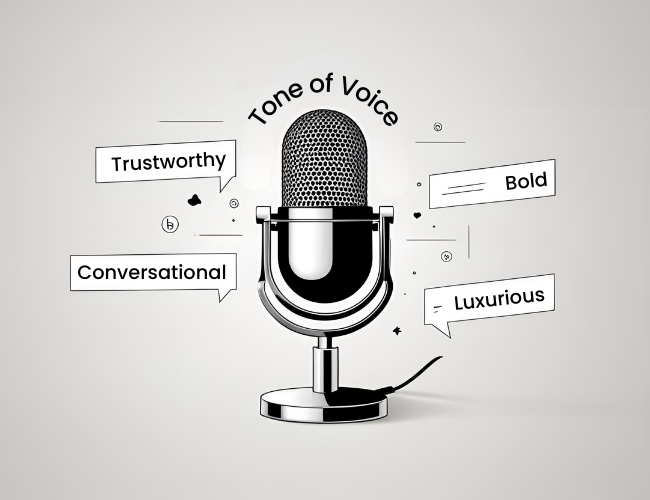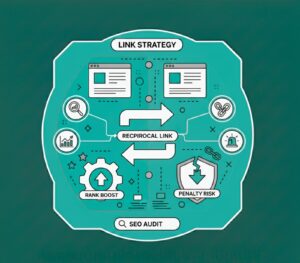What Is a Brand Tone of Voice?
Blogs | Branding
Written By: Yasmin Qureshi
Blogs | Branding
Written By: Yasmin Qureshi
Introduction
Your logo isn’t the only thing that sets you apart from competitors—your brand’s tone of voice is just as crucial. It shapes how you communicate, giving your business a distinct personality that resonates with your audience. A well-defined tone of voice builds trust, sets expectations, and fosters lasting relationships.
Your tone of voice can be friendly and conversational, professional and authoritative, or bold and edgy—it all depends on how you want your brand to be perceived.
In today’s article, we’ll explore what a brand tone of voice is, why it matters, and how you can define yours to create a powerful, lasting connection with your audience.

What is a Brand Tone of Voice?
A brand tone of voice is the distinctive way a business communicates with its audience. It reflects the brand’s personality, values, and mission, shaping how messages are delivered across various channels, such as websites, social media, advertisements, and customer services interactions.
Why is Brand Tone of Voice Important?
A strong brand tone of voice creates a recognisable and consistent identity across all platforms. It establishes a clear personality, making it easier for customers to connect with and remember your brand.
A well-defined tone strengthens emotional connections by resonating with your audience’s values and expectations. It also sets your brand apart from competitors, giving it a unique voice.
Most importantly, consistency in tone enhances trust and credibility, leaving customers feeling confident in your brand’s authenticity and reliability.

Key Elements of a Brand Tone of Voice
The key elements of a brand tone of voice define how your brand communicates and ensures consistency across all messaging. These include:
1. Personality: Is the brand friendly, professional, playful, authoritative, or empathetic?
2. Language & Vocabulary: The choice of words and phrases that align with your brand’s identity. Does it use simple and approachable language, or technical and formal?
3. Consistency: A strong tone of voice is applied consistently across all communications to build brand recognition.
4. Emotional Impact: The way a brand speaks influences how people feel about it. A warm and engaging tone fosters connection, while a formal and professional tone builds credibility.
5. Audience Alignment: The tone should resonate with your target audience’s preferences, values, and expectations. For example, a youthful, energetic brand will sound different from a luxury, high-end brand.
How to Define Your Brand Tone of Voice
Defining your brand tone of voice starts with understanding your audience—identifying their demographics, preferences, and expectations to ensure your messaging resonates with them.
Next, aligning your tone with your core brand values helps maintain authenticity and consistency, reinforcing your mission and vision.
Analysing existing content can provide valuable insights by revealing patterns in past messaging, helping you refine you approach.
Developing a tone of voice guide is essential for consistency, offering clear guidelines on language, style, and tone across all communications.
Finally, testing and refining your tone based on feedback and performance ensures it remains effective, adaptable, and relevant to your audience over time.

Examples of Brand Tone of Voice
Defining your brand’s tone of voice can feel like a daunting task, but one effective way to start is by analysing the brands around you—particularly your competitors. This can give you insight into how different tones resonate with audiences and help you pinpoint the tone that best represents your business. To get a clearer picture, let’s explore a few well-known brands and their distinct tones of voice:
- Innocent Drinks
- Playful and friendly tone.
- Uses casual, humorous, and quirky language.
- Apple
- Minimalist and inspirational tone.
- Communicates in a simple, clear, and aspirational manner.
- Nike
- Motivational and bold tone.
- Uses strong, empowering, and action-driven language.
Common Mistakes to Avoid
When developing a brand tone of voice, there are several common mistakes to avoid:
Inconsistency across platforms can confuse audiences and weaken brand recognition. It’s important to use a consistent tone across all communications and platforms.
Failing to align with the target audience can result in messaging that feels irrelevant or unrelatable, reducing engagement and trust.
Overcomplicated language creates a barrier. Avoid using overly technical or complex wording, which may alienate potential customers instead of drawing them in.
Lastly, lacking authenticity can make a brand seem insincere or untrustworthy, diminishing its credibility and connection with its audience.
By addressing these pitfalls, brands can create a tone of voice that is clear, compelling and effective.

Conclusion
A strong and consistent tone of voice builds brand recognition, credibility, trust, and creates emotional connections with your audience. By defining and continually refining your tone of voice, your messaging will remain authentic, engaging and aligned with your brand values.
Take a moment to analyse your current brand tone of voice—does it truly reflect your brand’s personality? If not, now is the perfect time to develop a brand tone guide that helps you communicate more effectively and consistently.
Want some more?
Latest Insights & News

Revolutionising Marketing: The Rise of Situational Content Strategies
Situational content strategies involve tailoring content to specific moments, contexts, or audience behaviours. By aligning content with real-time trends, seasonal needs, and user intent, brands can increase relevance, improve engagement, and strengthen SEO performance.

Smart Ways to Identify and Fill Content Gaps Fast: A Complete Strategy Guide
Content gaps refer to missing information, unanswered questions, or underserved topics in your existing content. Identifying these gaps helps you create targeted, high-value pages that improve search visibility, satisfy user intent, and outperform competitors.

Reciprocal Links in SEO: Do They Still Boost Rankings or Risk Penalties?
For the keyword “reciprocal links SEO,” focus on explaining how reciprocal linking works today. Reciprocal links are not harmful by default, but Google can flag excessive or manipulative link exchanges. To stay safe, only exchange links when they are contextually relevant, natural, and valuable to users.




